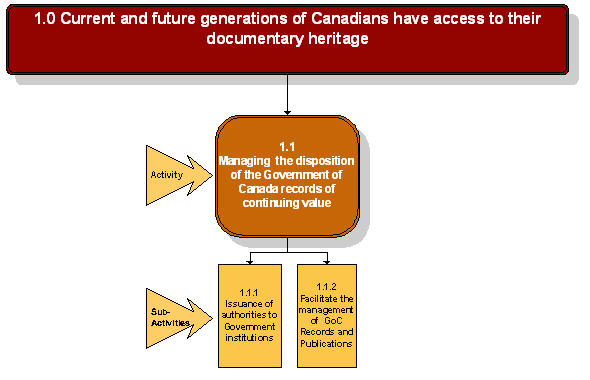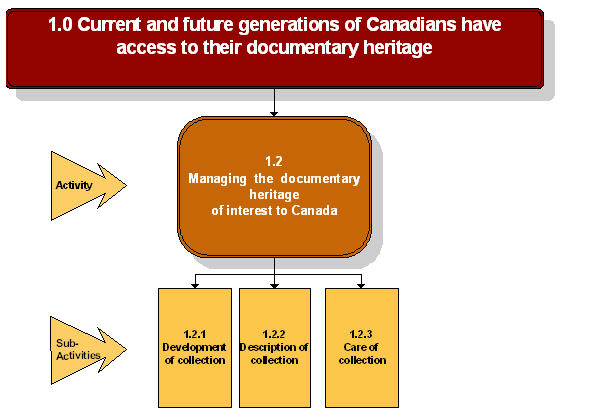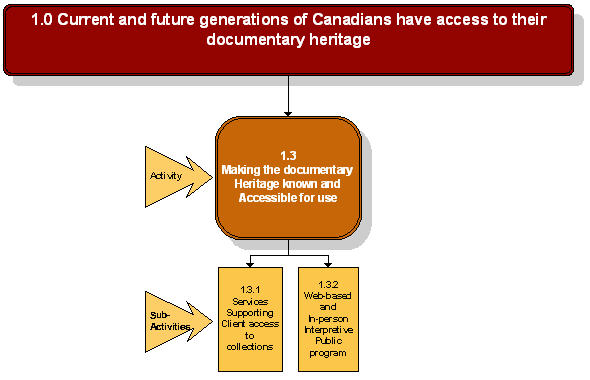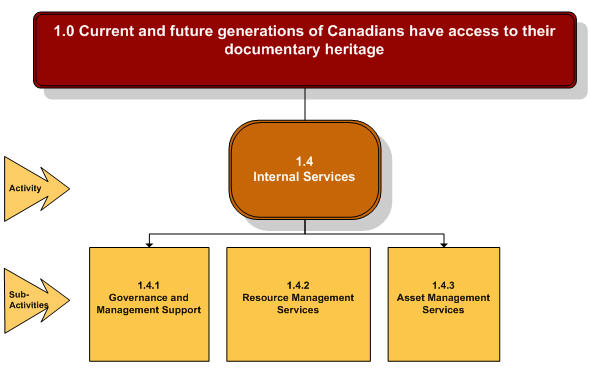Common menu bar links
Breadcrumb Trail
ARCHIVED - Library and Archives Canada
 This page has been archived.
This page has been archived.
Archived Content
Information identified as archived on the Web is for reference, research or recordkeeping purposes. It has not been altered or updated after the date of archiving. Web pages that are archived on the Web are not subject to the Government of Canada Web Standards. As per the Communications Policy of the Government of Canada, you can request alternate formats on the "Contact Us" page.
Section II - Analysis of Program Activities by Strategic Outcome
2.1 Strategic Outcome: Current and future generations of Canadians have access to their documentary heritage
Library and Archives Canada (LAC) focuses planning and reporting to Parliament and the central agencies of the Government of Canada through the achievement of the strategic outcome noted above.

This section presents LAC program activities and the expected results our institution wants to achieve in 2009-10. It shows the resources that LAC plans to dedicate to each program activity, the means by which we expect to reach our goals, and the performance indicators we will use to measure our progress. Finally, this section indicates the benefits that Canadians will get through these program activities:
- Program Activity 1.1 - Managing the disposition of the Government of Canada records of continuing value
- Program Activity 1.2 - Managing the documentary heritage of interest to Canada
- Program Activity 1.3 - Making the documentary heritage known and accessible for use
- Program Activity 1.4 - Internal Services

1.0 Current and future generations of Canadians have access to their documentary heritage
Activities
1.1 Managing the disposition of the Government of Canada records of continuing value
Sub-Activities
1.1.1 Issuance of authorities to government institutions
1.1.2 Facilitate the management of GoC Records and Publications
Through the issuance of Records Disposition Authorities, the development of recordkeeping advice, tools and guidance, and the provision of Regional Service Centres services for departments of the government of Canada, Library and Archives Canada (LAC) enables and facilitates the management of information within federal agencies and ensures that government's archival and historical records are identified and appropriately preserved.
| Program activity: Managing the disposition of the Government of Canada records of continuing value | |||||
|---|---|---|---|---|---|
| Human Resources (FTEs) and Planned Spending ($ thousands) | |||||
| 2009-10 | 2010-11 | 2011-12 | |||
| FTEs | Planned spending | FTEs | Planned spending | FTEs | Planned spending |
| 155 | 9,860.7 | 152 | 9,832.7 | 152 | 9,801.7 |
| Note: Please refer to the Expenditure Profile for explanations on spending trends. | |||||
| Expected Results Access to Government of Canada (GC) archival and historical records |
Performance Indicators Narrative (to meet the needs of clients, acquisition and preservation of the GC documents).
|
Targets In development. |
|||
| LAC is redefining the performance indicators for this program activity and will complete that process, including target-setting, during 2009-10 | |||||
Program Activity Summary
This program activity centres on the core LAC role as a leader in the development and implementation of Government of Canada information management and recordkeeping policies.(www.collectionscanada.gc.ca/government/index-e.html) We, with our partners
across the government, are implementing a new government-wide approach to records and information management across Canada. Our goal is that departments and agencies manage consistently all the information and records that they create and use and that they dispose of records that are no longer of operational use, in line with established standards.
(www.collectionscanada.gc.ca/government/news-events/007001-5000-e.html)
(www.collectionscanada.gc.ca/democracy/023023-3404-e.html)
Planning Highlights
Our workplan for government information management and recordkeeping reflects the five LAC priorities in Section I. In 2009-10, we will begin a five-year plan to implement a newly approved Recordkeeping Directive (RD). Developed in partnership with Treasury Board's Chief Information Officer Branch, the Directive addresses the demonstrated need for recordkeeping standards and practice across the Government of Canada. It will establish departmental recordkeeping requirements to enable and support programs, services and ongoing operations, in-line with departmental performance and accountability requirements.
The Recordkeeping Directive and supporting actions will change the approach to recordkeeping across the government over time. We have designed the RD to focus efforts on those digital and other documents that are most likely to have ongoing business or archival value. That focus will mean relatively fewer documents retained, with simpler access to those that remain. Consistent with our commitment to collaboration and learning from our partners, the RD provides departments and agencies with a clearer sense of their roles in effective recordkeeping, while we strengthen our own practices. The design and implementation of the Recordkeeping Directive draw on lessons learned by LAC and federal departments in exploring better ways of managing government recordkeeping in recent years. Highlights of that implementation, and related actions to complement it, include:
- Monitoring and efficiency reviews of existing and new Records Disposition Authorities with federal institutions to ensure that our partner departments and agencies are managing and disposing of records properly and effectively, and to identify needed Authorities changes in line with the RD (www.collectionscanada.gc.ca/government/disposition/index-e.html);
- Finalization of assessment projects that LAC and partners have been using to test approaches to particular recordkeeping issues for possible eventual use across the government (www.collectionscanada.gc.ca/government/news-events/007001-5105-e.html) ;
- Completion and launch of public service recordkeeping training and toolkits;
- Moving forward with the implementation of the New Storage Model (NSM) for Government Records, which will better control storage costs while improving accessibility (www.collectionscanada.gc.ca/government/news-events/007001-5105-e.html#c);
- Continued progress in identifying and eliminating paper records of no value in our storage facilities and improving access to the remaining records through measures such as better descriptive information and new finding aids.
Benefits for Canadians
- Canadians have easier access to government records of business or archival value, including in support of their access to information and privacy requests.
- Disposal of records of no business or archival value eliminates related storage costs. (www.oag-bvg.gc.ca/internet/English/parl_oag_200311_06_e_12929.html)
2.1.2 Program Activity 1.2: Managing the documentary heritage of interest to Canada

1.0 Current and future generations of Canadians have access to their documentary heritage
Activities
1.2 Managing the documentary heritage of interest to Canada
Sub-Activities
1.2.1 Development of collection
1.2.2 Description of collection
1.2.3 Care of collection
The building of a national documentary resource for all aspects of the study of Canada is fundamental to the mandate of Library and Archives Canada (LAC). The Library and Archives Canada collection consists of published and unpublished materials in a variety of formats acquired through Legal Deposit, agreements with government institutions and selected private materials purchased or received by donation. To access the contents of collections, they must be appropriately described. Description can take many forms and provide various layers of access but is governed by nationally and internationally accepted codes of practice. At the same time, holdings are also described to meet Canadians' expectations for timely and equitable access. Once materials enter the LAC collection they are managed to ensure their long-term preservation and accessibility through policies, procedures and various programs including storage, conservation, preservation, and copying. To fulfill its role as a permanent repository of government records and publications, Library and Archives Canada enters into agreements with government institutions to ensure that documents of historical and archival value are eventually transferred to LAC.
| Program activity: Managing the documentary heritage of interest to Canada | |||||
|---|---|---|---|---|---|
| Human Resources (FTEs) and Planned Spending ($ thousands) | |||||
| 2009-10 | 2010-11 | 2011-12 | |||
| FTEs | Planned spending | FTEs | Planned spending | FTEs | Planned spending |
| 513 | 57,287.8 | 502 | 66,861.8 | 502 | 41,855.8 |
| Note: Please refer to the Expenditure Profile for explanations on spending trends. | |||||
| Expected Results The management of the LAC collection is improved to enhance long-term access and to better reflect the Canadian experience. |
Performance Indicators Effectiveness of the strategy in collection management (2009-10).
|
Targets In development. |
|||
| 2008-09 will be a baseline year against which future targets will be set | |||||
Program Activity Summary
Priorities for action under this program activity in 2009-10 and beyond particularly reflect the LAC priority to ensure that we become a knowledge institution that benefits from the digital information environment. Our goal is to develop and manage a rich and varied documentary heritage collection for current and future generations of Canadians. We will continue to address the emerging digital environment and foster partnerships with stakeholders involved in knowledge management across Canada and around the world. We will develop strategies and introduce new technologies in our collection management and will continue to act on compelling issues, such as preserving priority items most at risk. We will leverage technology to preserve the collection and provide Canadians with access to that heritage. These actions will continue to involve aligning our resources with our core activities and mandate.
Planning Highlights
In 2009-10, we will develop a more strategic approach to our acquisition efforts. We will continue to put into place elements of the technological platform needed to support management of the collection in a digital environment. We will address the collection management challenges that are most critical to our core activities.
Strategic Development
- We will develop an approach for Integrated Documentation to guide, coordinate and articulate LAC decisions and interventions to identify, select and preserve Canada's documentary heritage. The approach will focus our program activities on organizational outcomes and results that enable LAC to:
- effectively document Canada and Canadian society,
- establish sources and contexts of knowledge that enrich understanding of Canada's democracy, community, culture, people and history over time, and
- explain decisions and interventions in support of these objectives within the meaning and intentions of the Library and Archives of Canada Act.
- LAC will further develop a new Collection Content Strategy to clarify what we particularly want to acquire for the collection and why we want them. It will take into account how we can collaborate with partners on acquisitions and will be integrated with the new LAC Integrated Documentation approach.
Collection Management Tools and Supports
We will put in place the infrastructure needed to support the management of our collection in a digital information world through the following projects:
- We continue developing the base for Trusted Digital Repository (TDR) services and increase their use. TDR services allow LAC and other knowledge institutions to receive documentary heritage produced in digital formats (e.g., electronic publications, websites) and match that with consistent frameworks, systems and tools to make those items then accessible to Canadians, no matter where they were deposited initially.
- We will continue developing AMICAN, a project that began in 2004 to integrate the information related to the items in our collection. It will support improved management of our collection and improve its accessibility for Canadians.
Addressing Collection Management Challenges
We will better address the many challenges in collection management by focusing our resources in the areas of highest priorities, supporting our core activities, e.g., Digital, Integrated Documentation and Preservation. More specifically:
- LAC will launch a strategic digitization plan that aims to create up to 30 million digital images of items in our collection between 2009-10 and 2013-14. This will enable us to put those images online for Canadians and users around the world with documentation that will make locating images easier.
- LAC will advance a new digital records program to support the more strategic acquisition of digital records from government and the private sector and deal with the items we already have but have not processed.
- LAC will begin to implement a five-year audio-visual strategy in which we intend to copy up to 160,000 hours of audio and video material in our collection from obsolete audio-visual formats to digital file formats. This strategy will initiate an ongoing migration program to ensure that Canadians will have access to audio-visual heritage, regardless of technology changes.
- In the context of a new Integrated Documentation approach, we will implement a new Web Archiving Strategy to guide our choices on the number and types of websites to gather and the supporting processes to get the most strategically-relevant results, given LAC collection priorities and available resources.
Benefits for Canadians
- The LAC collection better reflects the diverse Canadian experience and responds to Canadians' broad variety of interests and needs in terms of documentary heritage.
- Canadians have greater access, online and in other digital delivery forms, to more digital items in our collection, both those we digitize and those that we acquire.
- Canadian audio-visual heritage is preserved for, and accessible to, current and future generations of Canadians.
- Canadian websites are strategically collected and preserved for current and future generation of Canadians.
- Canadian documentary heritage is managed efficiently and highest priorities are addressed based on clear strategies.
2.1.3 Program Activity 1.3: Making the documentary heritage known and accessible for use

1.0 Current and future generations of Canadians have access to their documentary heritage
Activities
1.3 Making the documentary heritage known and accessible for use
Sub-ActivitiesActivities
1.3.1 Services supporting client access to collectionsActivities
1.3.2 Web-based and in-person interpretive public programs
All materials that become part of the Library and Archives Canada (LAC) collection are intended for use by those interested in Canada. LAC provides information and services including consultation, research and lending across multiple channels to facilitate access to the documentary heritage by a wide variety of clients. It also establishes activities, such as the learning program and encourages or organizes activities such as exhibitions, publications and performances, to make known and interpret Canada's documentary heritage. LAC also provides information resources and standards such as the national catalogue and supports the infrastructure necessary to ensure its accessibility to those interested in Canada and its heritage.
| Program activity: Making the documentary heritage known and accessible for use | |||||
|---|---|---|---|---|---|
| Human Resources (FTEs) and Planned Spending ($ thousands) | |||||
| 2009-10 | 2010-11 | 2011-12 | |||
| FTEs | Planned spending | FTEs | Planned spending | FTEs | Planned spending |
| 230 | 24,612.0 | 225 | 22,170.0 | 225 | 21,360.0 |
| Note: Please refer to the Expenditure Profile for explanations on spending trends. | |||||
| Expected Results Clients use the documentary heritage for personal enrichment, lifelong learning and to produce works of value to Canada. |
Performance Indicators Narrative (Analysis of use according to client segments).
|
Targets In development. |
|||
| 2008-09 will be a baseline year against which future targets will be set | |||||
Program Activity Summary
LAC serves Canadians by providing access to collections that are a source of enduring knowledge and contributing to the cultural, social and economic advancement of Canada as a free and democratic society. LAC provides that access through a range of services accessible through different channels, including online and in-person, nationally and internationally. In 2009-10, we will continue to take actions that demonstrate LAC strategic priorities set out in Section I, whether through the use of digital delivery, partnerships, programming in many parts of Canada or choices guided by client needs.
Planning Highlights
- Over the past two years, LAC has been increasingly focusing on providing its services through the Internet. Over the next year, we will highlight and present in an engaging, audience-focused manner, new and expanded databases of digitized documents, photographs, videos, films and music online at (www.collectionscanada.gc.ca), using standard Web and Web 2.0 technologies. We will also continue to make our collections available online, through partners and via sites such as Flickr (www.collectionscanada.gc.ca/whats-new/013-359-e.html) that can expand our
reach.
- On November 7, 2008, the Government of Canada decided to end its search for a permanent site for the Portrait Gallery of Canada. At that time, the Minister of Canadian Heritage and Official Languages committed to exploring ways to make the collection more accessible to Canadians (www.pch.gc.ca/pc-ch/infoCntr/cdm-mc/index-eng.cfm?action=doc&DocIDCd=CJM081821). LAC will work to implement this commitment. In the very short term, we will work with many regional and national partners to present Festival Karsh
in 2009-10 (www.portraits.gc.ca/index-e.html). New portrait programming is also being planned for the Vancouver 2010 Olympic and Paralympic Winter Games. Further means of increasing access to the collection will be explored and implemented as appropriate.
- Following the federal government decision not to pursue a permanent Portrait Gallery project at this time, LAC will continue to give access to the portrait collection as announced by the Minister of Canadian Heritage and Official Languages on November 7, 2008 (http://www.pch.gc.ca/pc-ch/infoCntr/cdm-mc/index-eng.cfm?action=doc&DocIDCd=CJM081821). Our commitment to reach more audiences across Canada will be demonstrated through our work with many regional and national partners to present Festival Karsh in 2009-10 (www.portraits.gc.ca/index-e.html). New portrait programming is being planned for the Vancouver 2010 Olympic and Paralympic Winter Games. Finally, to pursue the commitment announced by the Minister of Canadian Heritage and Official Languages, LAC will explore the best way to
maintain the access to its portrait collection.
- LAC continues to support the Learning Centre, a popular learning destination for history and social science teachers across the country (www.collectionscanada.gc.ca/education/index-e.html). Popular programs will be extended into 2009-10, such as the
LAC Forum on Canadian Democracy (www.collectionscanada.gc.ca/democracy/index-e.html).
- Collaborative arrangements will be crucial to providing access to LAC's collections. By partnering with sister organizations such as Bibliothèque et Archives nationales du Québec (www.thatsmyfamily.info/), commercial enterprises such as The Generations Network (www.ancestry.ca/)and the TD Summer Reading Club program (www.td-club-td.ca/index-e.html), and professional networks such as the Canadian Council of Archives and the Initiative for Equitable Library Access (www.collectionscanada.gc.ca/iela/index-e.html), LAC will increasingly reach diverse audiences and meet our national mandate.
- LAC is developing a corporate research plan to align our research initiatives with corporate priorities; among these activities we will undertake further research with clients in 2009-10. Through a Services Strategy to be completed in 2009-10, we expect to address opportunities linked to the four most common reasons that
people seek out items in our collection: genealogical research, academic and educational research, research to establish rights/benefits or to support litigation (veterans' benefits, land claims), and to produce media or cultural industry products (books, films). In 2009-10 LAC will continue to value the advice provided by a
volunteer Services Advisory Board representing clients and partners (www.collectionscanada.gc.ca/the-public/pcsab/index-e.html).
- Gathering more sophisticated client information and investing in partner relations in 2009-10 will allow LAC to encourage the use of online services, and to target potential users across Canada.
Benefits for Canadians
- Canadians will have enhanced access to our collection for their personal enrichment, to establish rights and benefits or support litigation, or to produce works of value to Canadians.
- Partnerships will enable us to reach more Canadians.
- A contribution to building an enhanced sense of identity within Canadian society and social cohesion.
2.1.4 Program Activity 1.4: Internal Services

1.0 Current and future generations of Canadians have access to their documentary heritage
Activities
1.4 Internal Services
Sub-Activities
1.4.1 Government and Management Support
1.4.2 Resource Management Services
1.4.3 Asset Management Services
| Financial Resources ($ thousands) |
||
|---|---|---|
| 2009-10 | 2010-11 | 2011-12 |
| 29,578.4 | 29,495.4 | 29,404.4 |
| Human Resources (Full-time Equivalents) |
||
| 2009-10 | 2010-11 | 2011-12 |
| 234 | 230 | 230 |
Note: Please refer to the Expenditure Profile for explanations on spending trends.
Internal services make fundamental contributions to the achievement of the LAC priorities set out in Section I, while ensuring compliance with Government of Canada legislation, regulations and policies. In LAC plans, these services are specifically identified as "enablers" because our actions in areas such as human resources, information technology, infrastructure, communications and other corporate support functions are consistently identified as critically important elements to the overall strategies for reaching our goals. We are pursuing comprehensive and strategic approaches in these enablers that will help us get results in all our other program activities, often with economies of scale, improved consistency and efficiency through better coordination of priorities and actions.
Planning Highlights
-
Governance and Management Support
- LAC will reduce the number of policies, to keep the most relevant and redesign others in light of LAC's direction and government-wide commitments to reduce the "web of rules."
- A new approach to partnering for LAC will be developed to enable LAC to extend its reach and deliver more fully on its mandate; with clear roles and responsibilities within LAC concerning partnering; and proper management of LAC partnering activities.
- An improved corporate research capacity will begin with a new, ongoing process for tracking trends and intelligence of relevance to the LAC mandate, priorities and operations.
- LAC evaluations will take place to establish and apply lessons learned.
-
Resource Management Services
This group of services support improved effectiveness and includes three of the collaborative and interdisciplinary initiatives described in Section I (professional competencies, enabling functions and infrastructure) that will help LAC to better focus on our core activities.- A new integrated human resources plan will take into account the evolution of LAC and the workforce, skills, competencies and workplace environments that we need.
- Our recruitment efforts will address our need to attract people for highly specialized positions, while reflecting Canada's workforce diversity.
- An Information Technology Architecture will be developed to enable LAC to deliver on the digital initiatives that we are pursuing across all program activities, while coordinating IT investments effectively.
- Development and implementation of technology solutions to enable LAC staff to acquire, preserve and provide access to digital information, combined with improved management of IT projects.
- A new senior-level committee will oversee major IT infrastructure decision making to ensure the most strategically effective use of IT resources.
- Improvements to LAC's internal information management strategy include the implementation of an integrated Electronic Document and Record Management System, the development of a strategy and process for acquiring and storing electronic records, and the development of expanded capacity for managing and archiving both electronic and paper documents at LAC.
-
Asset Management Services
Activities in this area of greatest strategic significance in 2009-10 are those that particularly address the risks to the collection related to our infrastructure.- We will continue to accommodate the growth of the collection and take efforts to ensure that the collection is held in appropriate conditions that limit the impacts of temperature changes, humidity and other factors.
- LAC expects to launch the construction of a new Nitrate Preservation Facility, which will enable us to preserve old films and photographs, for completion in 2010.
- The elimination of records that have no ongoing business or archival value will enable us to allocate that space more effectively.
